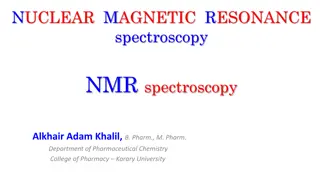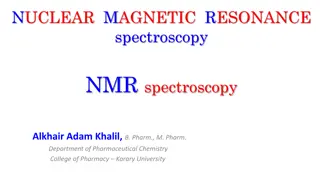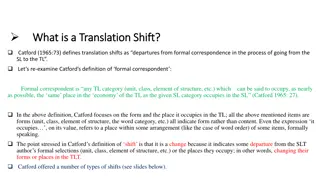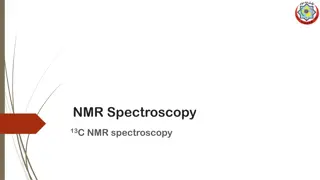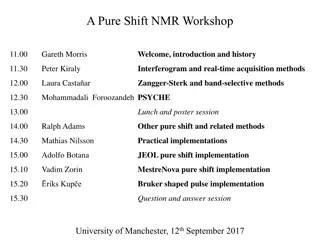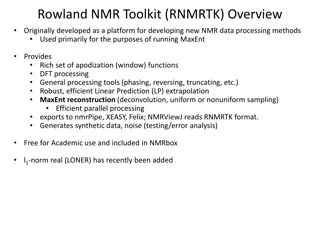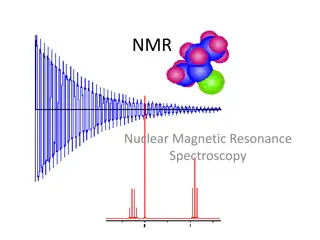Understanding NMR Spectroscopy and Chemical Shifts
Nuclear Magnetic Resonance (NMR) spectroscopy is a powerful technique for analyzing molecular structures based on the chemical shifts of protons. In an NMR spectrum, peaks correspond to different protons in a compound, with their positions, intensities, and spin-spin splitting providing valuable information. Magnetic shielding by electrons influences the energy needed for protons to resonate, leading to shifts in peak positions known as chemical shifts. This article explores the principles of NMR spectroscopy, the effects of magnetic shielding, and how electron density impacts chemical shifts.
Download Presentation

Please find below an Image/Link to download the presentation.
The content on the website is provided AS IS for your information and personal use only. It may not be sold, licensed, or shared on other websites without obtaining consent from the author. Download presentation by click this link. If you encounter any issues during the download, it is possible that the publisher has removed the file from their server.
E N D
Presentation Transcript
NMR Spectroscopy Interpretation of NMR spectrum
Nuclear Magnetic Resonance Spectroscopy 1H NMR The Spectrum An NMR spectrum is a plot of the intensity of a peak against its chemical shift, measured in parts per million (ppm).
Nuclear Magnetic Resonance Spectroscopy 1H NMR The Spectrum NMR absorptions generally appear as sharp peaks. Increasing chemical shift is plotted from left to right. Most protons absorb between 0-10 ppm. The terms upfield and downfield describe the relative location of peaks. Upfield means to the right. Downfield means to the left. NMR absorptions are measured relative to the position of a reference peak at 0 ppm on the scale due to tetramethylsilane (TMS). TMS is a volatile inert compound that gives a single peak upfield from typical NMR absorptions.
Nuclear Magnetic Resonance Spectroscopy Features of 1H NMR spectrum Four different features of a 1H NMR spectrum provide information about a compound s structure: Position of signals Number of signals Intensity of signals. Spin-spin splitting of signals.
Magnetic Shielding If all protons absorbed the same amount of energy in a given magnetic field, not much information could be obtained. But protons are surrounded by electrons that shield them from the external field. Circulating electrons create an induced magnetic field that opposes the external magnetic field.
Shielded Protons Magnetic field strength must be increased for a shielded proton to flip at the same frequency.
Protons in a Molecule Depending on their chemical environment, protons in a molecule are shielded by different amounts.
Electron drawing Electron drawing (c) (a) (b) CH3-CH2-Br (a) (b) CH3-CH2-O-CH2-Br Electron poor more deshielded (high frequency) Electron rich shielded (low frequency) Electron rich shielded (low frequency) Electron poor deshielded (high frequency) Deshielding: nucleus feels strong magnetic field Increased energy gap E Higher frequency needed to achieve resonance Electron dense (poor) means downfield chemical shift Shielding: nucleus feels weak magnetic field Reduced energy gap E Lower frequency needed to achieve resonance Electron dense (rich) means upfield chemical shift The shifts in the positions of NMR signals resulting from the Shielding/Deshielding by the Electrons is called as "CHEMICAL SHIFTS"
Factors affecting chemical shift Chlorine "deshields" the proton, that is, it takes valence electron density away from carbon, which in turn takes more density from hydrogen deshielding the proton. Factors affecting chemical shift Electronegative element Dependence of the chemical shift of CH3X on the element X Electronegativity inductive effect Compound CH3X CH3F CH3OH CH3Cl CH3Br CH3I CH4 (CH3)4Si F O 3.5 3.40 Cl 3.1 3.1 Br 2.8 2.7 I H 2.1 1.0 Si 1.8 0 Element X EN Chemical shift Anisotrophic effect 4.0 4.3 2.5 2.2 Hydrogen bonding TMS Most deshielded Deshielding increases with EN of atom X The chemical shift of a C H bond increases with increasing alkyl substitution. RCH2-H R2CH-H R3C-H 0.9 ppm 1.3 ppm 1.7 ppm Increasing alkyl substitution, increasing chemical shift Vanderwaal s deshielding
Factors affecting chemical shift Substitution effects on chemical shift The effect increases with greater numbers of electronegative atoms Factors affecting chemical shift CH4 1.0 CH3Cl 3.1 CH2Cl2 5.3 CHCl3 7.3 The effect decreases with increasing distance from the electronegative atom. The effect completely vanished at the fourth bond from the electronegative atom Electronegativity inductive effect -CH2-Br 3.3 -CH2-CH2-Br 1.7 X-CH2-CH2-CH2-Br 1.3 1.6 ppm Anisotrophic effect 0.9 ppm 3.3 ppm Hydrogen bonding The effect of absence of electronegative atoms Methyl Methylene Methine Vanderwaal s deshielding 0.9 ppm 1.2 ppm 1.7 ppm
Factors affecting chemical shift Factors affecting chemical shift Characteristic Values of Chemical Shifts Electronegativity inductive effect It is possible to predict the chemical shifts for the protons in a wide variety of compounds, including alcohols, ethers, ketones, esters, and carboxylic acids. Anisotrophic effect Hydrogen bonding Vanderwaal s deshielding
Factors affecting chemical shift Effects on neighbouring functional groups on chemical shift Factors affecting chemical shift Electronegativity inductive effect Anisotrophic effect Hydrogen bonding Vanderwaal s deshielding
Factors affecting chemical shift The opposite of isotropy which means uniformity in all directions. So, anisotropy is non -uniformity. Now for different compounds this anisotropy is different as different distribution of electrons around nuclei. These compounds are: Alkene Alkyne Benzene Others Factors affecting chemical shift Electronegativity inductive effect Anisotrophic effect Hydrogen bonding Vanderwaal s deshielding
Factors affecting chemical shift Factors affecting chemical shift Alkene protons adjacent to alkene (C=C-H) are deshielded by anisotropy effect, so, chemical shift will be induced. Electronegativity inductive effect Anisotrophic effect Hydrogen bonding Vanderwaal s deshielding
Factors affecting chemical shift Alkyne All groups in a molecule having electrons generate secondary anisotropic field. In alkynes (C C),the system will shields the proton, thus causing decrease in chemical shift of alkynes. Also the proton next to the alkynes carbon experience the anisotropic effect towards shielded side. Factors affecting chemical shift Electronegativity inductive effect Anisotrophic effect Hydrogen bonding Vanderwaal s deshielding
Factors affecting chemical shift Benzene In a magnetic field, the six electrons in benzene circulate around the ring creating a ring current. The magnetic field induced by these moving electrons reinforces the applied magnetic field in the vicinity of the protons. The protons thus feel a stronger magnetic field and a higher frequency is needed for resonance. Thus they are deshielded and absorb downfield. Factors affecting chemical shift Electronegativity inductive effect Anisotrophic effect Hydrogen bonding Vanderwaal s deshielding
Factors affecting chemical shift Others Factors affecting chemical shift Electronegativity inductive effect Anisotrophic effect Hydrogen bonding Vanderwaal s deshielding
Factors affecting chemical shift Hydrogen bonding (HB) effect The chemical shift depends on how much HB is taking place (observed in high conc. solutions. HB lengthens the O-H bonds and reduces the valence electron density around the proton, so, it is deshielded and shifted downfield in the NMR spectrum. Alcohols vary in chemical shift from 0.5 ppm (free OH) to about 5.0 ppm (lots of HB). Factors affecting chemical shift Electronegativity inductive effect Anisotrophic effect Hydrogen bonding Vanderwaal s deshielding
Factors affecting chemical shift Vanderwaal's Dishielding In overcrowded molecules, it is possible that some protons may be occupying sterically hindered position. Electronegative cloud of bulky groups (hindering groups) will tend to repell the electron cloud surrounding proton. Thus, such a proton will be deshielded and will resonate a slightly higher values of (chemical shift) than expected in the absence of this effect Factors affecting chemical shift Electronegativity inductive effect Anisotrophic effect Hydrogen bonding Vanderwaal s deshielding


